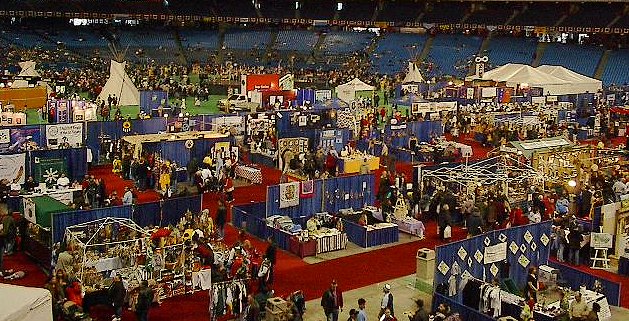


The contemporary state of First Nations performing arts was on display at the ninth annual Canadian Aboriginal Festival at the SkyDome in Toronto. The fourth annual Canadian Aboriginal Music Awards took place as part of the festival on Thursday, 28 November. The sixteen categories ranged from Best Pow Wow Album (Traditional) to Best Rap/Hip Hop Album. On Sunday when one of the organizers was asked if a list of award winners was available, the question was met first with puzzlement, and then with amusement, before he responded that “We are all winners.” Indeed, the mammoth event provided a winning formula for all, participants and visitors alike.
Sadie Buck of the Six Nations Women Singers was the Artistic Director for the festival, and the range and quality of events on offer spoke to the comprehensiveness of her vision of First Nations performing arts. The main performance area in the SkyDome was given over to the Toronto Star Pow Wow (major corporate and government sponsorship was much in evidence), while acts on a smaller scale were featured in the Music and Performance Tents.
The 20 or so events on offer over the weekend in the Music Tent ranged from Inuit throat singing to Native blues and rock performers. Unfortunately the tent was not well sound proofed, and as a result the powerful drums of the main stage pow wow performers threatened to drown out the quieter acts, such as Inuit throat singers Kathy Kettler and Kendra Tagoona. Similar problems beset the Performance Tent.
The number and variety of First Nations publications and organizations who were participating in the festival is impressive. Publications being distributed at the SkyDome included The Native Canadian (the newspaper of the Native Canadian Centre of Toronto), Tansi (Toronto’s Aboriginal newspaper), Neechee Culture (a First Nations arts magazine from Winnipeg), Spirit (a new Indigenous magazine from Wasauksing First Nation, Parry Sound, that was launched at the festival), and the various publications of the Aboriginal Multi-Media Society, based in Edmonton. Some of the other organizations participating included the Association for Native Development in the Performing and Visual Arts (established in 1972 by the late Cree Elder James Buller), Native Women in the Arts (founded by Sandra Laronde in 1993, with a current membership of over 3,000 women and arts organizations across Canada), and the Aboriginal Peoples Television Network.
Some 150 booths were set up by various educational, food services, crafts, commercial, sporting, and governmental organizations. Many of these groups have sophisticated web sites, which can now be accessed through the Aboriginal Canada Portal set up recently by the federal government in partnership with six national Aboriginal Organizations: the Assembly of First Nations, the Congress of Aboriginal Peoples, the Council for the Advancement of Native Development Officers, the Inuit Tapirisat of Canada, the Métis National Council, and the Native Women’s Association of Canada. The portal, at the web address www.aboriginalcanada.gc.ca, includes over 14,500 links and 17,000 web pages. It is an accurate reflection in the digital arena of the scope and variety of First Nations activities and organizations which were on display at the Canadian Aboriginal Festival.